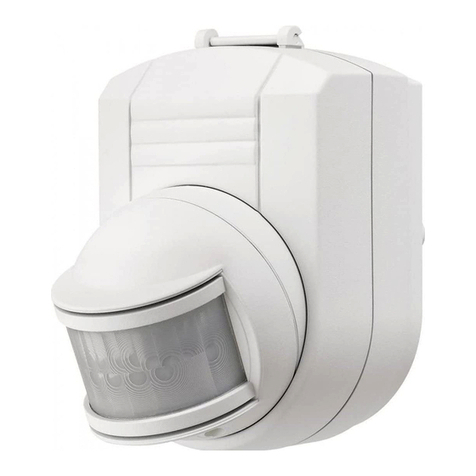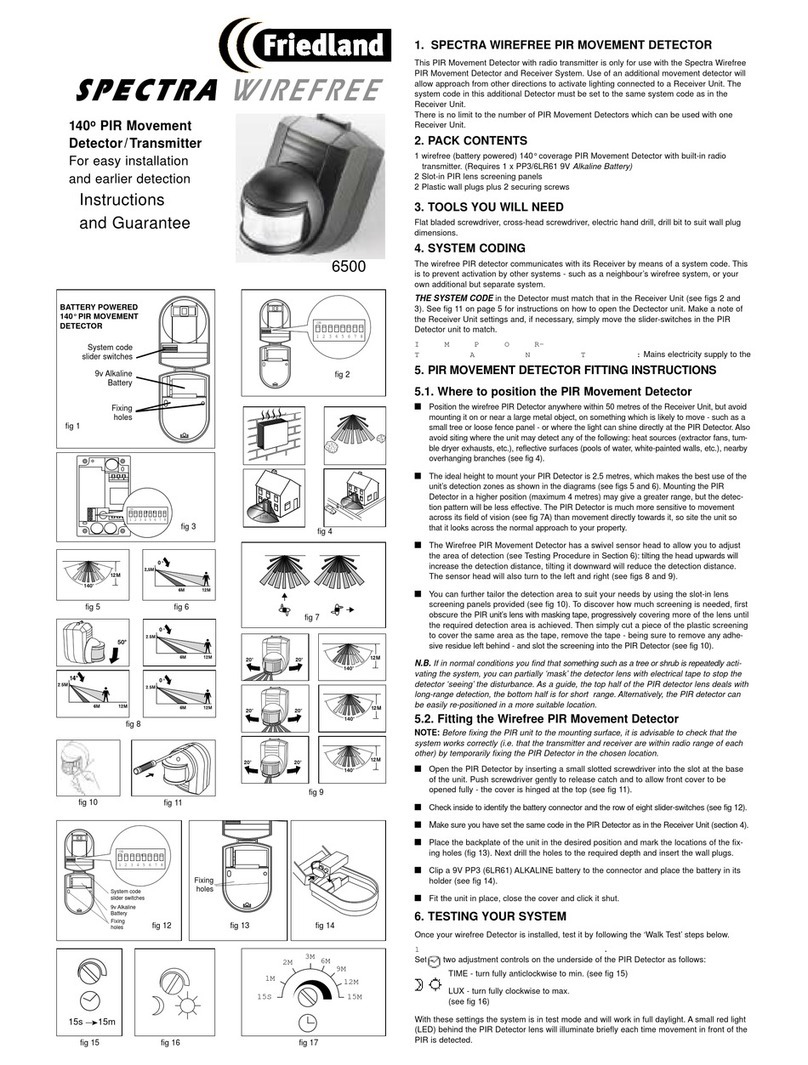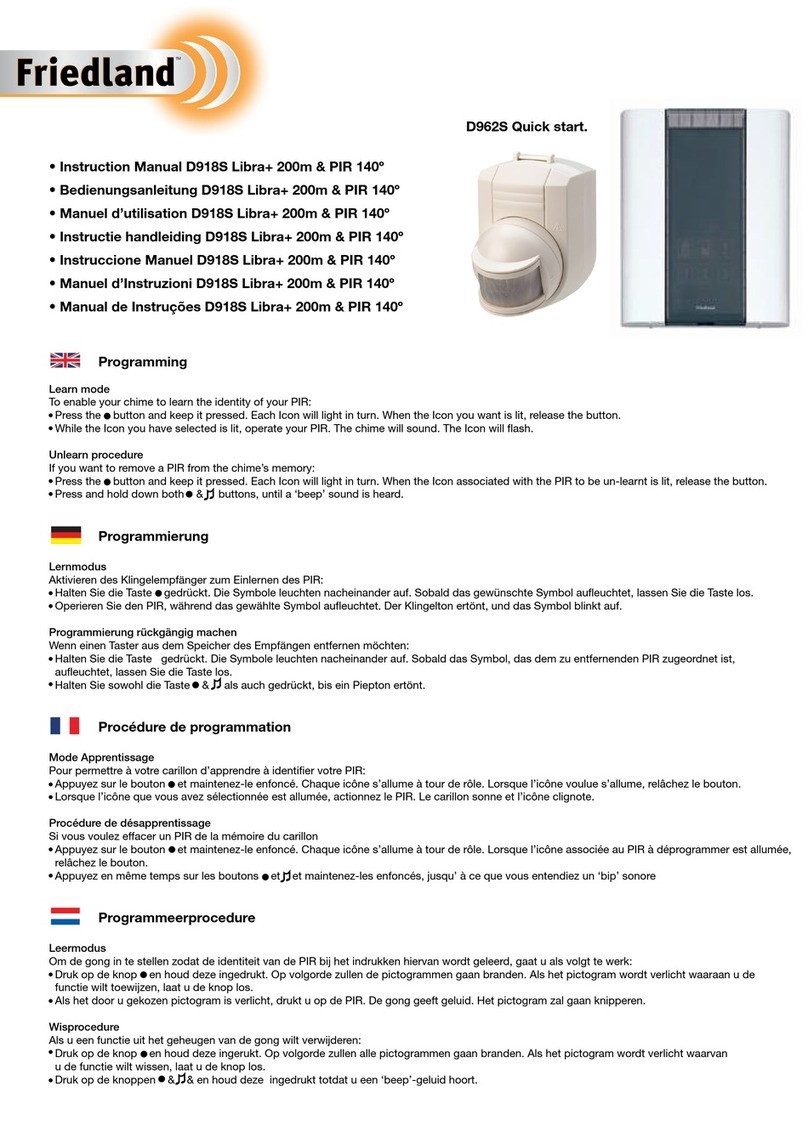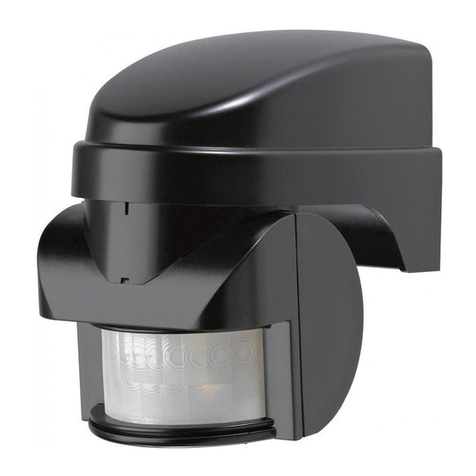1. SPECTRA WIREFREE PIR MOVEMENT DETECTOR &
RECEIVER SYSTEM
Your Spectra Wirefree Passive Infrared (PIR) Movement Detector and Receiver System
provides you with an advanced system which can utilise an existing light, or any new
exterior lamp you choose. It gives you the freedom to fit any style of light fitting, and still
enjoy the peace of mind and convenience of effective automatic lighting.
No Wires! - The system uses radio technology to activate the light. With no need for
wiring, the PIR Detector can be easily located wherever it is needed within 50
metres of its receiver - which in turn controls the light. Even mains garden lighting
can easily be converted to automatic operation.
This system uses radio wave technology to activate mains lighting. Radio wave
transmission can be affected by thick walls, metal window frames, aluminium rein-
forced UPVC windows and doors, metallic parts of house structures and similar
objects. Whilst the majority of installations are not adversely affected, you may
have to experiment a little to discover the best location for your PIR/Transmitter
and Receiver Unit.
The PIR Movement Detector/Transmitter and the Receiver Unit are weatherproof,
and suitable for outdoor installation.
2. PACK CONTENTS
■1 wirefree (battery powered) 140° coverage PIR Movement Detector with built-
in radio transmitter. Requires 1 x PP3/6LR61 9v Alkaline Battery
■1 mains powered receiver unit
■4 plastic wallplugs plus 4 securing screws
■
4 rubber cable grommets (2 with hole pierced, 2 unpierced)
■2 fixing screw sealing plugs
■2 slot-in PIR lens screening panels
3. ELECTRICAL CABLING TO THE RECEIVER UNIT
The Receiver Unit requires connection to a 220-240V 50Hz mains electricity supply.
The Receiver Unit is designed to accept most types of 10Arated 2 or 3 core cable up to
14mm in diameter. It is recommended that only one cable is fitted through a single grommet.
Except when installed in a dry and protected environment, the Receiver Unit is not suitable for
connection using separate single core wires - the kind sometimes found in conduit cabling. The
receiver unit is not designed for direct connection to conduit.
4. TOOLS YOU WILL NEED
Flat bladed screwdriver, terminal or electrician’s screwdriver, cross-head screwdriver,
electrical cable cutter/wire stripper. Electric hand drill, drill bit to suit wall plug dimensions.
5. CHOOSING YOUR SYSTEM CODE
The wirefree PIR Detector communicates with its Receiver by means of a system
code. This is to prevent activation
by other systems - such as a neighbour’s wirefree system, or your own additional but
separate system. If such disturbance is unlikely, leave the code at its factory setting.
TO SELECT A SYSTEM CODE simply move some of the eight slider-switches in
the PIR Detector unit - leave some in their original position. (See figs 3 and 4). See
fig 25 on page 15 for instructions on how to open the Detector unit. This is now
your system code; the slider-switches in your Receiver Unit must now be set in the
same pattern. Make a note of the settings on a piece of paper, so you can double-
check your code without having to re-open the PIR Detector.
6. RECEIVER UNIT FITTING INSTRUCTIONS
6.1 Choosing a wiring method for the receiver
Before starting work, it is essential to decide precisely where to fit the Receiver
Unit, and how you intend to wire it. i.e., which cable entry points you will use and
therefore how long the cable will need to be. There are 2 types of installation -
please choose the appropriate method for your situation:
Wiring method A. Using existing cabling only
This approach is used when you wish to leave the existing power supply cabling to
a light fitting unchanged. The cable is cut at a convenient point and the receiver
connected to the cut cable ends.
Wiring method B. Using new or a combination of new and existing
cabling
This approach is used when new cabling is required throughout the installation, or
when only the cabling from the power supply or light fitting needs to be changed.
is important to take the following factors into account when deciding where
the receiver should go:
■The surface must be flat
■The power supply cable must be connected to terminalA
■The light fitting cable must be connected to terminal B
■The entry point hole next to terminal B cannot be used for the power supply
cable (shown in fig 1 as entry point 4)
Follow the instructions relevant to your installation
A. Using existing cabling only
IMPORTANT:Mains electricity supply must be turned off before cable is cut. If in doubt
consult a qualified electrician.
Choose a position for the Receiver Unit - which can be mounted horizon-
tally (fig 5) or vertically (fig 6)
This may be outdoors near the light fitting or perhaps indoors near the mains
supply consumer box. It’s important to remember that with only the cut existing
cable to work with you must fit the unit so that the cable entry holes 1 and 4 at
either end of the receiver can be used (See figs. 5 and 6).
Check there are no obstructions to fitting the unit in your chosen position.
Cut cable, making sure there is enough free cable either side of the cut to allow
connection to the Receiver’s
Cut cable, making sure there is enough free cable either side of the cut to allow
connection to the Receiver’s terminals.
Do not trim the cable ends yet.
B. Using new, or a combination of new and
existing cabling
IMPORTANT: Mains electricity supply must be turned off before cable is
cut. If in doubt consult a qualified electrician.
Choose a position for the Receiver Unit - which can be mounted vertically
(figs 7&8) or horizontally (fig 9)
Decide where the Receiver Unit is to be fixed and which cable entry points will be
used, checking that the cables will fit without obstructions.
Any of the cable entry points in the unit may be used (see examples in figs 7, 8
and 9), so long as the supply cable is connected to TERMINAL A and the cable to
the light or lights is connected to TERMINAL B. You can wire through the end entry
points or the rear entry point to suit the circumstance. Note that the entry hole
(No.4) next to TERMINAL B CANNOT be used for the supply cable.
Prepare the cable
Cut the existing cable to a convenient length for handling, yet with enough spare to
allow connection to the relevant terminal when Receiver box is in position.
Install the new length of cable, again leaving a generous amount spare at the
receiver box end.
D O N OT reconnect power yet.
6.2 Fitting and connecting the Receiver Unit
The following fitting instructions can be used for wiring method A or wiring
method B
Mark the position of the Receiver
■Remove the cover from the Receiver Unit.
■Place the receiver case in the required position, ensuring that it is on a flat
surface, and check
that both cables will be able to enter the chosen
entry holes.
■Mark the position of the fixing holes (fig 10).
Prepare access openings and drain hole
■The access openings in front of the cable entry holes can be enlarged by remov-
ing ‘knock outs’. If the cable to be passed through the access opening is too
large in diameter to fit, knock out the extra material with a small screwdriver to
create suitably larger openings. (See fig 11)
■If the rear access hole is chosen, use firm pressure with your screwdriver to
remove the knock out and create the hole. Clean up the edges of the hole with
a sharp knife to ensure a good seal for the grommet.
■Make sure that the pierced grommets are in position in the entry holes to be
used, and that the blank unpierced grommets are fitted in the other unused
entry points. Insert the grommets the correct way round. (See fig 12)
■There are two moisture drain holes - see fig 1. For your chosen installation,
determine which will be in the lower position when fitted. Open up this drain
hole to its full diameter using a small screwdriver or drill
(See fig 13)Fixing in place
■Drill holes where marked. If fitting against a masonry wall, drill holes using a
masonry drill bit to suit wall plug dimensions. Drill the holes to the required
depth and insert the wall plugs.
■Before fixing the receiver case in place, feed cable ends through pierced grom-
mets in the entry holes, being careful not to pull out the grommets.
■Push fixing screws through the sealing plugs (see fig 14) - ensuring that the
seals are correctly seated in the fixing holes - and screw receiver case to wall.
Connecting cable ends
■Cut the cable ends so they easily reach the terminals.
■Trim back the outer insulation to a convenient length, but allow at least 5mm to
remain protruding from the inside of the grommet when the cable is fed
through.
■If you’re fitting the cable to the light fitting(s) through an entry hole near TERMI-
NAL A, you must remove the outer insulation from the wires to allow them to fit
into the channel giving access to TERMINAL B (see figs 7 and 8).
■Strip the LIVE and NEUTRAL wires’ insulation to expose 6mm of bare copper
wire (if the wire is the stranded kind, twist the strands together so that no
strands fray).
■If the cable contains an insulated EARTH wire, strip this in the same way.
■Make a final check that the cables from the power source and the light fitting will
be connected at the correct ends of the Receiver Unit - (the power supply must
be connected to TERMINAL A, and the light fitting must be connected to TERMI-
NAL B).
■Connect both cable ends to their terminal blocks, inserting each separate wire
into the relevant terminal.
■For the cable from the supply, LIVE is connected to the L terminal, NEUTRAL is





























